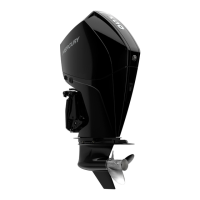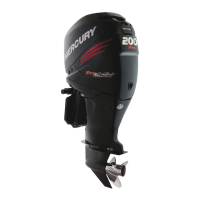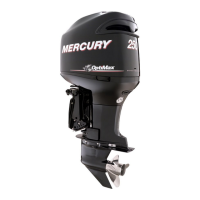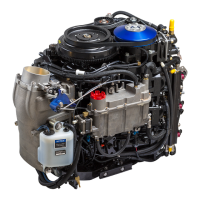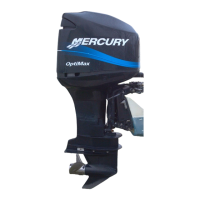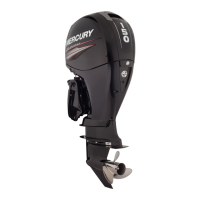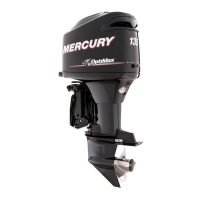Charging and Starting System
Page 2B-28 90-8M0050731 MAY 2011
Starter Motor Does Not Turn
Test Number Procedure Test Results
3
Set the meter to read ohms, auto range. Connect the
meter at test point 5, between the common
powerhead ground and the battery negative post.
No continuity ‑ There is an open circuit between the battery
negative post and the powerhead.
• Check for a loose or corroded battery negative cable
connection at the powerhead and the battery.
• Check for an open battery negative cable.
Continuity indicated ‑ proceed to Test 4.
4
Set the meter to read volts, auto range. Disconnect
the black ground wire on the start solenoid at test
point 6. Connect the meter between the start
solenoid ground wire terminal and a common
powerhead ground. Turn the key switch to the
"START" position.
Battery voltage indicated:
Check the black ground wire for a poor connection to the
common powerhead ground. Reconnect the ground wire to
the start solenoid and proceed to Test 5.
No battery voltage indicated:
Reconnect the ground wire to the start solenoid and proceed
to Test 5.
5
Connect the meter at test point 8, between the start
solenoid and a common powerhead ground. Turn
the key switch to the "START" position.
Battery voltage indicated:
Proceed to Test 6.
No battery voltage indicated:
• The neutral start switch is open.
• The yellow/red wire is open between the key switch and
the start solenoid.
• The key switch is defective.
6
Connect the meter at test point 7, between the start
solenoid and a common powerhead ground. Turn
the key switch to the "START" position.
Battery voltage indicated and the starter solenoid does not
click.
• The starter solenoid is defective.
• The wire between the start solenoid and the starter
solenoid is open or corroded. Check for continuity
between test points 4 and 7.
No battery voltage indicated:
Proceed to Test 7.
7
Disconnect the key switch and check for battery
voltage at test point 11, the red wire (pin A), and a
common powerhead ground.
Battery voltage indicated:
Key switch is defective.
No battery voltage indicated:
Check the 15 amp harness fuse.
Starter Will Not Stay Engaged (Chatter)
Test Number Procedure Test Results
1
Disconnect the yellow/red exciter wire from the
starter solenoid at test point 4. Measure the
resistance between the exciter terminal of the starter
solenoid and the starter solenoid metal housing.
Starter solenoid hold‑in coil resistance is 1.2 Ω ± 10%.
• Starter solenoid hold‑in coil is good. Proceed to Test 2.
Starter solenoid hold‑in coil resistance is in excess of 1.2 Ω
± 10%.
• Starter solenoid hold‑in coil is defective.
2
Remove the starter motor brush lead from the starter
solenoid at test point 9. Measure the resistance
between the exciter terminal of the starter solenoid
and the starter solenoid brush lead terminal.
Starter solenoid pull‑in coil resistance is 0.3 Ω ± 10%.
• Starter solenoid pull‑in coil is good.
• Ensure battery is fully charged.
Starter solenoid pull‑in coil resistance is in excess of 0.3 Ω ±
10%.
Starter solenoid pull‑in coil is defective.
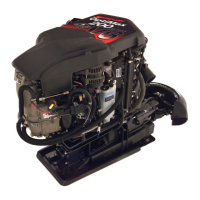
